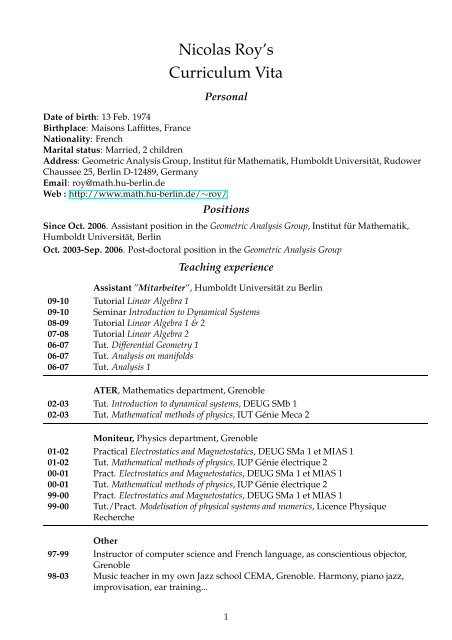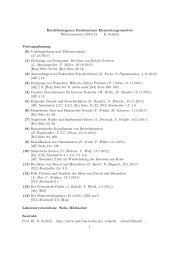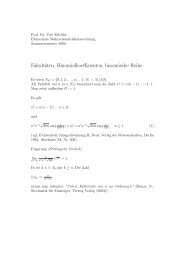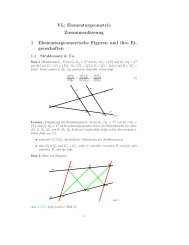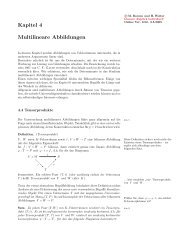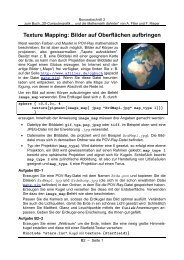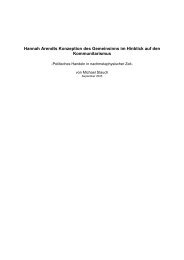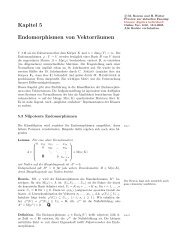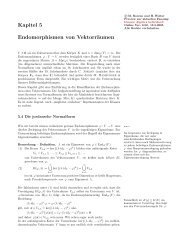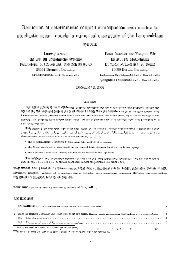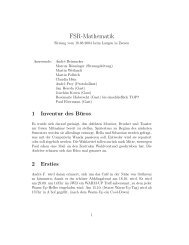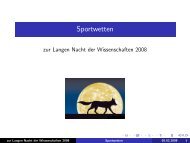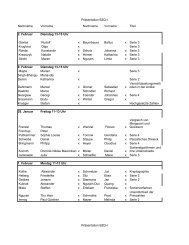Nicolas Roy's Curriculum Vita - Institut für Mathematik - Humboldt ...
Nicolas Roy's Curriculum Vita - Institut für Mathematik - Humboldt ...
Nicolas Roy's Curriculum Vita - Institut für Mathematik - Humboldt ...
Create successful ePaper yourself
Turn your PDF publications into a flip-book with our unique Google optimized e-Paper software.
<strong>Nicolas</strong>Roy’s<br />
<strong>Curriculum</strong><strong>Vita</strong><br />
Personal<br />
Date of birth: 13Feb. 1974<br />
Birthplace: MaisonsLaffittes, France<br />
Nationality: French<br />
Maritalstatus: Married, 2 children<br />
Address: GeometricAnalysisGroup,<strong>Institut</strong><strong>für</strong><strong>Mathematik</strong>,<strong>Humboldt</strong>Universität,Rudower<br />
Chaussee 25,Berlin D-12489,Germany<br />
Email: roy@math.hu-berlin.de<br />
Web: http://www.math.hu-berlin.de/∼roy/<br />
Positions<br />
Since Oct. 2006. Assistant position inthe GeometricAnalysisGroup,<strong>Institut</strong> <strong>für</strong><strong>Mathematik</strong>,<br />
<strong>Humboldt</strong> Universität, Berlin<br />
Oct. 2003-Sep. 2006. Post-doctoral position inthe GeometricAnalysisGroup<br />
Teaching experience<br />
Assistant ”Mitarbeiter”, <strong>Humboldt</strong> Universität zuBerlin<br />
09-10 Tutorial Linear Algebra1<br />
09-10 Seminar Introduction toDynamicalSystems<br />
08-09 Tutorial Linear Algebra1&2<br />
07-08 Tutorial Linear Algebra2<br />
06-07 Tut. DifferentialGeometry1<br />
06-07 Tut. Analysison manifolds<br />
06-07 Tut. Analysis1<br />
ATER, Mathematics department, Grenoble<br />
02-03 Tut. Introduction todynamicalsystems,DEUG SMb 1<br />
02-03 Tut. Mathematicalmethodsof physics,IUTGénieMeca 2<br />
Moniteur,Physics department, Grenoble<br />
01-02 Practical Electrostaticsand Magnetostatics, DEUGSMa 1et MIAS1<br />
01-02 Tut. Mathematicalmethodsof physics,IUPGénieélectrique 2<br />
00-01 Pract. Electrostaticsand Magnetostatics, DEUGSMa 1etMIAS1<br />
00-01 Tut. Mathematicalmethodsof physics,IUPGénieélectrique 2<br />
99-00 Pract. Electrostaticsand Magnetostatics, DEUGSMa 1etMIAS1<br />
99-00 Tut./Pract. Modelisationof physicalsystemsand numerics,Licence Physique<br />
Recherche<br />
Other<br />
97-99 Instructor ofcomputer science and French language, asconscientious objector,<br />
Grenoble<br />
98-03 Music teacherin my own Jazzschool CEMA,Grenoble. Harmony, pianojazz,<br />
improvisation, eartraining...<br />
1
Education<br />
PhD in Mathematics, Sept. 2003, <strong>Institut</strong> Fourier, Grenoble (France), under supervision of<br />
Y. Colin deVerdière, on deformationsof classicaland semi-classicalcompletelyintegrable systems<br />
Master degree in Theoretical Physics, 1997, Ecole Normale Supérieure de Lyon (France).<br />
Master thesis on Conformal transformations of (pseudo)Riemannian manifolds<br />
UndergraduateandgraduatestudiesinPhysics,1992-1997,UniversitéJosephFourier,Grenoble<br />
Practicalperiods<br />
1997, <strong>Institut</strong> dePhysique Nucléaire de Lyon, Lyon, 3months<br />
1996, <strong>Institut</strong> deFísica d’AltesEnergies, Barcelona, 6 months<br />
1995, European Synchrotron Radiation Facility, Grenoble, 2 months<br />
1993, <strong>Institut</strong> desSciences Nucléaires, Grenoble, 2 months<br />
Invitedtalks<br />
7th Sep. 2009,"Quantum dynamics”conference, Lyon, France<br />
14th May. 2009, "Dynamicalsystems”seminar, Freie Universität, Berlin<br />
21stApr. 2009,"Nonlineardynamics”seminar, Freie Universität, Berlin<br />
16th Mar. 2009,"Symplecticand contactgeometry"seminar,Brussels<br />
21stJan. 2009,Workshop "Resonancesin physics and mathematics", Marseille (France)<br />
14th May. 2008, ”Geometric analysis and spectral theory” seminar, <strong>Humboldt</strong> Universität,<br />
Berlin<br />
13th Dec. 2006, ”Geometric analysis and spectral theory” seminar, <strong>Humboldt</strong> Universität,<br />
Berlin<br />
19th Jan. 2004,”Mathematical physics” seminar, Technische Universität, Berlin<br />
3rd Dec. 2003, ”Geometric analysis and spectral theory” seminar, <strong>Humboldt</strong> Universität,<br />
Berlin<br />
12thNov. 2003,Workshop”SpectralproblemsforSchrödinger-typeoperatorsII”,<strong>Humboldt</strong><br />
Universität, Berlin<br />
13th May2003,Topology seminar, AarhusUniversity, Aarhus(Denmark)<br />
Research visits<br />
Feb. 2009,MFO Oberwolfach (Allemagne), 2weeks, grant ”Research in Pairs”<br />
Mai2006,Roma (Italy), 1 week, invited byC. Liverani.<br />
Administrative duties<br />
19-25 Jul. 2008, co-organiser and webmaster of the workshop ”Symplectic Field Theory 3”,<br />
Berlin<br />
24-26 Apr. 2008, co-organiser and webmaster of the conference”Mathematical Physics and<br />
Spectral Theory”,Berlin<br />
2-3Nov2007,co-organiserandwebmasteroftheconference”GeometricAnalysisandSpectral<br />
Theory”,Berlin<br />
2006-2009,Organiser of the ”Geometricanalysis”seminar<br />
2
Attended conferences and summerschools<br />
1999-2009, many international mathematics workshops and conferences : Munich, Strasbourg,<br />
Berlin, Bruxelles, Peyresq, Lille, Leipzig, Nantes, Giens, Stare Jablonki, Cargèse, Bordeaux,<br />
Villetaneuse,Montpellier,Reims,...<br />
Languages<br />
Mother tongue : French<br />
Fluently spoken andwritten languages : German,English, Polish<br />
Music in general andjazz in particular<br />
Trekking, climbing, skiing, biking<br />
Computers<br />
Personal Interests<br />
3
Published papers<br />
Listof publications 1<br />
[7] N. Roy and V. Humilière, The geometry of the space of fibrations. To appear in Ann.<br />
Global Anal. Geom. (2009)<br />
[6] N. Roy, F. Faure and J. Sjöstrand, Semi-classical approach for Anosov diffeomorphisms<br />
and Ruelleresonances. Open Math. Journal (2008),vol. 1,35–81<br />
[5] N. Roy, A semi-classical K.A.M. theorem. Comm. Partial Differential Equations 32<br />
(2007), no. 5, 745–770<br />
[4] N. Roy and F. Faure, Ruelle-Pollicottresonances for real analytic hyperbolicmaps. Nonlinearity<br />
19(2006), no. 6, 1233–1252<br />
[3] N. Roy, Intersections of Lagrangian submanifolds and the Mel’nikov 1-form. J. Geom.<br />
Phys. 56(2006), no. 11,2203–2229<br />
[2] N. Roy, Regular deformations of completely integrable systems. J. Symplectic Geom. 3<br />
(2005), no. 1, 1–16<br />
[1]N.Roy,Thegeometryofnondegeneracyconditionsincompletelyintegrablesystems. Ann.<br />
Fac. Sci. Toulouse Math. (6)14(2005), no. 4, 705–719<br />
Doctoral Thesis<br />
[0] N. Roy, Sur les déformations des systèmes complètement intégrables classiques et semiclassiques.<br />
Grenoble (France), September2003<br />
Submited articles<br />
N. Roy, A Weinstein’stubular neighbourhood for Lagrangian fibrations. ArXiv 0905.0594<br />
Articlesin preparation<br />
N. Royand V. Humilière,The geometryof the spaceof completelyintegrablesystems<br />
1 pdffiles availableatØØÔÛÛÛÑØÙÖÐÒÖÓÝ<br />
4
Summaries of published articles<br />
[0] Sur lesdéformationsdessystèmescomplètementintégrablesclassiquesetsemi-classiques<br />
Inthisthesis,westudyseveralaspectsofperturbationsofcompletelyintegrablesystems.<br />
The first part deals with completely integrable Hamiltonian systems (classical mechanics)<br />
and their deformations. This work as developped further and gave rise to the articles [1,2]<br />
described below. The second part concerns perturbations of semiclassical completely integrable<br />
systems. We introduce the theory of Pseudodifferential operators with small parameter<br />
on the torus. The particular algebraic structure of the torus provides a weel-defined<br />
notion of total symbol for these operators. The main results of this part were improved and<br />
are presented in[5].<br />
[1] Thegeometryofnondegeneracy conditions incompletelyintegrablesystems<br />
In K.A.M-like theorems one needs to impose nondegeneracy conditions on the completely<br />
integrable Hamiltonian H0 in order to insure that the set of Diophantine tori (which<br />
persist after a small perturbation H0 + εK) has large measure. These conditions are usualy<br />
given in action-angle coordinates, but it is possible to formulate them geometrically, by<br />
considering completely integrable systems defined on a symplectic manifold by a fibration<br />
in Lagrangian tori and a Hamiltonian function constant on the fibers. In this article, we<br />
give a geometric definition for several nondegeneracy conditions, we explain the different<br />
implication relation that exist between them, and we show the unicity of the fibration for<br />
non-degenerate Hamiltonians.<br />
[2] Regular deformationsofcompletelyintegrable systems<br />
Given a symplectic manifold (M, ω) and a fibration M → B in lagrangian tori, we show<br />
thatanyfamily φ ε ofsymplectomorphims canbedecomposed inauniquewayas φ ε = Φ ε ◦<br />
ϕ ε ,with Φ ε afamilyoffiber-preservingsymplectomorphimsand ϕ ε afamilyofHamiltonian<br />
symplectomorphims. This normal form is used in a second part to study deformations of<br />
non-degenerate regular completely integrable hamiltonian. Namely, we make explicit the<br />
spaceofperturbationsKofacompletelyintegrableHamiltonian H0,suchthattheperturbed<br />
Hamiltonian H0 + εK is“completelyintegrable up toO ε 2 ”.<br />
[3] Intersectionsof Lagrangian submanifoldsand the Mel’nikov1-form<br />
Mel’nikov’s theory/method deals with Hamiltonian systems H0 ∈ C∞ R2 with a hyperbolic<br />
point x0 and their perturbations Hε := H0 + εK, where H1 (t) ∈ C∞ R2 × R depends<br />
on the time in a periodic way. We assume that the stable and the unstable manifolds<br />
of x0 coincide, thus forming together a manifold of homoclinic points. Meln’ikov’s method<br />
provides a way to detect homoclinic points in the perturbed system Hε, in which the stable<br />
andunstable manifolddonolongercoincide. Namely,themethodpredictthatthesehomoclinic<br />
points are given by the zeros of a function (called “Mel’nikov function”) and that this<br />
function admitsan integral form, in which appearsonlythe flow of H0.<br />
This method extends to perturbations of Hamiltonian systems having two transversally<br />
hyperbolic periodic orbits linked by a heteroclinic manifold. Unfortunately, the most of<br />
the works on this topic deal always with models, written in a coordinate system and with<br />
an explicit splitting between periodic and transversal varaibles. Besides the fact that these<br />
models are non-generic, they alsohide the geometrical characterof the method.<br />
In this article, we develop the general theory of intersections of pairs of familiies of La-<br />
grangian submanifolds N ± ε , with N+ 0 = N− 0<br />
, and constrained to live in an auxiliary family<br />
of submanifolds N ± ε ⊂ Pε ⊂ M. We show that the intersections N + ε ∩ N − ε which survive<br />
when ε = 0 are detected by a 1-form on N0, called Mel’nikov 1-form. We show that it is<br />
the appropriate tool for studying heteroclinic points between two transversally hyperbolic<br />
5
periodicorbits. This1-formadmitsanintegralexpressioninvolvingonlytheflowof H0,but<br />
which is in general divergent. We give several ways to treat this divergence problem and<br />
we explain whyit doesapparentlynot appearin the above-mentionned particular models.<br />
[5] Asemi-classicalK.A.M. theorem<br />
We consider a semiclassical completely integrable system defined by a pseudodifferential<br />
operator ˆH, with small parameter ¯h, on the torus T d , whose total symbol is a classicaly<br />
completely integrable Hamiltonian H ∈ C ∞ T ∗ T d . We study perturbed operators of the<br />
form ˆH + ¯h κ ˆK, where ˆK is any pseudodifferential operator and κ > 0, and we show the<br />
existence ofsemiclassical normal forms forthese operators. Thisisused toconstruct a large<br />
number of quasimodes, in analogy with the K.A.M theorem in classical mechanics which<br />
proves the persistency of a large number of invariant tori after perturbation. Moreover, the<br />
first correction to the eigenvalues is related to the average of the symbol of the perturbation<br />
ˆK. In order to prove these result, one needs to perform a very precise analysis of the<br />
resonances and the diophantine tori with parameters dependingon ¯h.<br />
[4] Ruelle-Pollicottresonancesfor realanalytic hyperbolicmaps<br />
Weconsider two simplemodelsof uniformly hyperbolic dynamical systems : expansive<br />
maponthecircleS 1 andhyperbolicmaponthetorus T 2 ,andwestudythedecayoftimecorrelation<br />
functions, which isfundamental to establish other chaotic properties of the system.<br />
To achieve this, we study the Ruelle transfert operator ˆM defined as the pull-back operator<br />
ˆM (ϕ) = ϕ ◦ M, where M is a chaotic real analytic map on S 1 (resp. T 2 ) and ϕ ∈ L 2 S 1<br />
(resp. ϕ ∈ L 2 T 2 ). We show that the Ruelle-Pollicott resonances, which describe the time<br />
correlation functions Cϕ,φ (n) = ϕ. ˆM n (φ) dx, with n ∈ N, can be obtained as the eigenvalues<br />
of a trace class operator on L 2 S 1 (resp. L 2 T 2 ). We show moreover that these<br />
resonances accumulate exponentiallyfast on 0.<br />
[6] ASemi-classicalapproachfor Anosov diffeomorphismsand Ruelle resonances<br />
If f is an Anosov diffeomorphism on a compact manifold, the decay of the dynamical<br />
correlation functions is governed by the so-called Ruelle resonances. It follows from the<br />
works of Baladi & al and Liverani & al, that these resonances can be obtained by a suitable<br />
spectral analysisofthecomposition operator (oranotherone relatedto it)calledthe "Transfer<br />
operator". In this paper, we show how these results can be obtained by a systematic<br />
microlocal analysis, extending the approach of the previous work [4].<br />
[7] Thegeometryofthe spaceof fibrations<br />
We study geometrical aspects of the space of fibrations between two given manifolds<br />
M and B, from the point of view of Frechet geometry. As a first result, we show that any<br />
connected component of this space is the base space of a Frechet-smooth principal bundle<br />
with the identity component of the group of diffeomorphisms of M as total space. Second,<br />
weprovethatthespaceoffibrationsisalsoitselfthetotalspaceofasmoothFrechetprincipal<br />
bundle with structure group the group of diffeomorphisms of the base B.<br />
6


